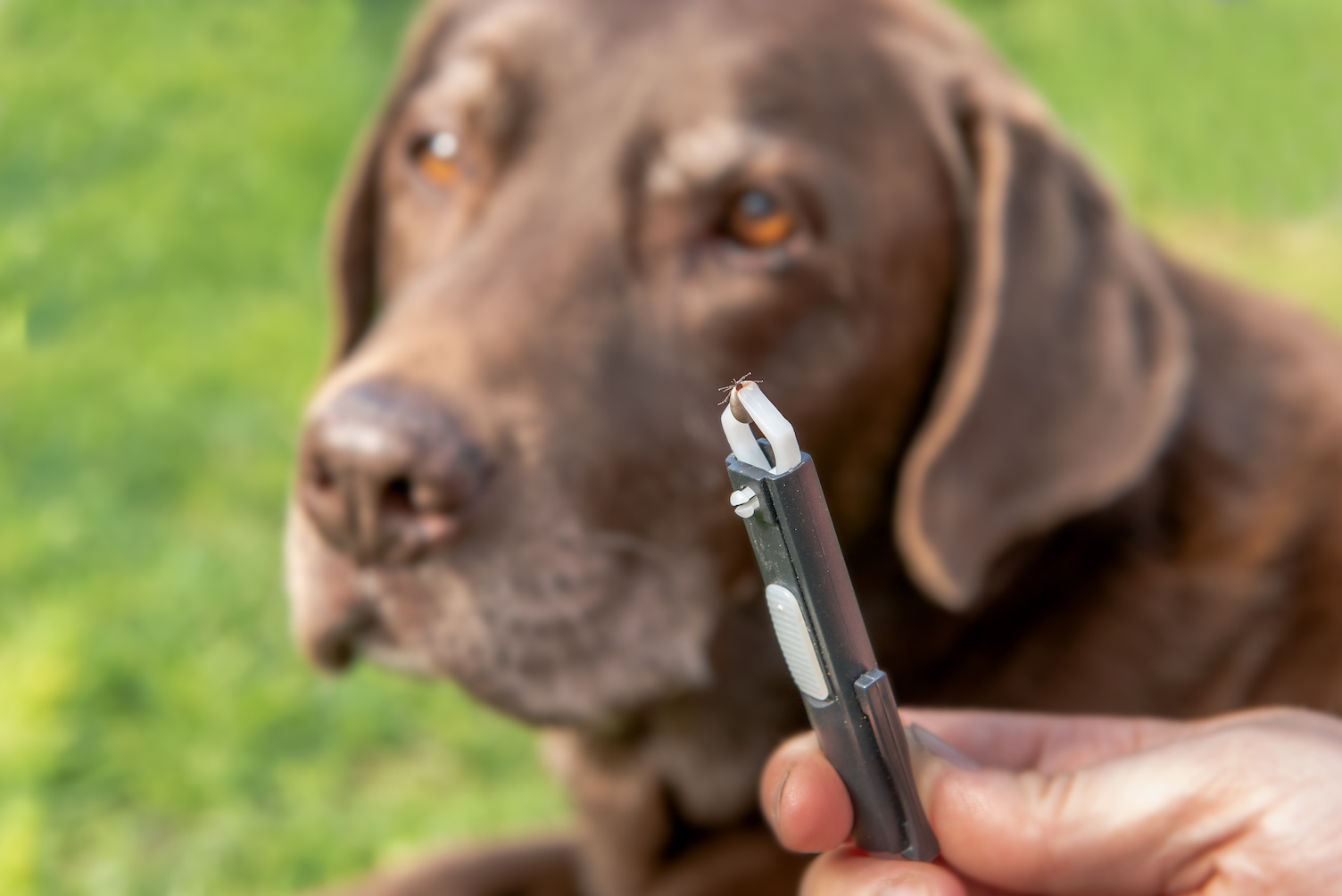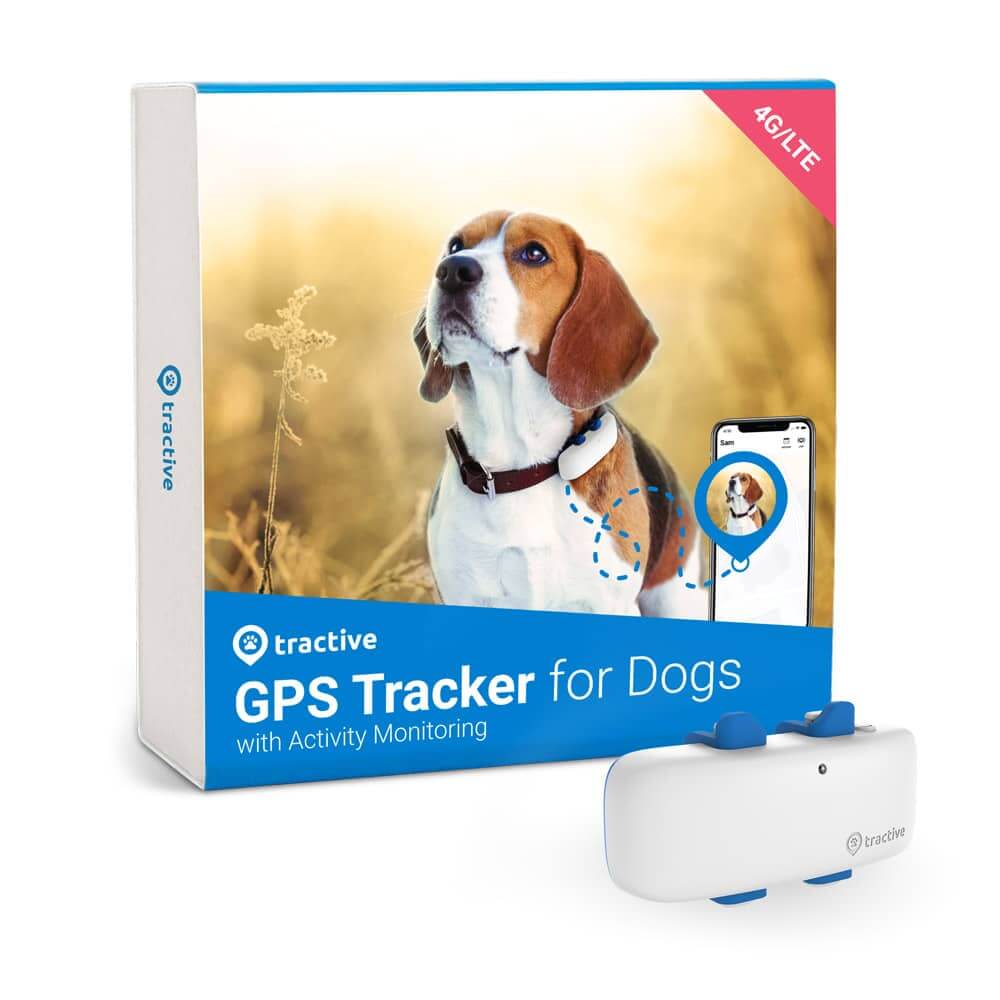 Approved by Dr. Dwight Alleyne, DVM
Approved by Dr. Dwight Alleyne, DVM Lyme Disease In Dogs: Signs You Shouldn’t Miss
Ticks tend to lurk around all year-long - which can open up your buddy's risk of picking up Lyme disease. Here's how to spot it & prevent it.

You wouldn’t be the first to wonder if you can pick up on an illness from your furry buddy. But while Lyme disease in dogs thankfully doesn’t tend to pass from animals to humans, it can still be fatal if left untreated. So if you’ve ever thought those pesky ticks outdoors were just a nuisance, think again. Here’s how to spot the signs – and why it makes sense to root out where your dog’s been running into ticks in the first place.

Find out how your dog spends their time.
Read moreWhat exactly is Lyme disease in dogs?
Lyme disease is a tick-borne bacterial disease that infects both dogs, cats, and a host of other animals. It’s caused by the bacterium, Borrelia burgdorferi, which lives in the salivary glands of infected black-legged ticks and western black-legged ticks.1
Sadly, adult ticks tend to be active from March to mid-May – but also from mid-August all the way to snowy November. Both young ticks (called nymphs) and adults can transmit Lyme disease. Even worse, most adult ticks are only around the size of sesame seeds. So they might not be easily visible – and you might miss out on them if you aren’t grooming your dog on the regular.
Importantly, not all ticks are carriers of Lyme disease. These parasites only pick up the infectious bacteria if they feed on the blood of rodents or deer that already have it. From where they can spread it to other animals – and even humans.
Can I get Lyme disease from my dog?
Well, both yes and no. Firstly, your dog (or cat) isn’t likely to give you any ticks directly.2 Humans don’t tend to be the best hosts for these species of ticks in general.
- However, your dog might still bring home some black-legged ticks clinging to their fur.
- Which can spread around your home and backyard – and eventually infect you as well.
- Some other species of ticks, like deer ticks (Ixodes scapularis) can infect both humans and dogs from your walks outdoors.
So it’s important to figure out…
What are the first signs of Lyme disease in dogs?
Sadly, the symptoms of Lyme disease in dogs might be quite easy to miss – since they tend not to be as specific as you might expect.3 In fact, these signs might not emerge until 3-30 days after the tick bite.
Including:
- Lethargy,
- A loss of appetite,
- Fever,
- Swollen lymph nodes,
- Swollen joints, which might make it difficult for your dog to move around as easily,
- A skin rash, after a few weeks
Now on the bright side, your dog might not necessarily fall sick – even if bitten, especially if they’ve got a strong immune system. The bacteria does take a while to spread around, after all.
⚠️ However, left untreated, Lyme disease can be fatal – damaging your buddy’s kidneys, nervous system, and heart. In other cases, it can even lead to paralysis and seizures, if it affects their nervous system.
How your vet might diagnose & treat your buddy
If you’ve brought your dog (or dogs) over to the vet, they’ll first start by checking your dog’s medical history and measuring their antibody levels. A high level of antibodies – and matching symptoms – might indicate your dog’s immune system is already on “fight” mode against the spread of harmful bacteria.
Your vet might also recommend other diagnostic tests to rule out other serious health conditions like a kidney infection. (Which might have similar symptoms.) Based on what’s causing your buddy’s symptoms, your vet might recommend:
- Antibiotics to deal with any infection, over weeks or even months, depending on the severity of the case,
- Anti-inflammatory medication deal with any swelling or pain,
- Physiotherapy to help your buddy with any mobility issues,
- A change in diet to help boost your dog’s immune system and help them get better faster.
- Special supplements to help with any joint pain.
- Avoiding any strenuous activity and plenty of rest as your dog recovers.
- Any followup treatment, as required – especially to monitor your dog’s symptoms.
Where is my dog likely to run into ticks?
Spring and summer tend to be peak tick months – but don’t let your guard down during the cozy fall or winter months either. Ticks are tenacious little critters and can be active throughout the year, waiting for your dog to pass by and latch on to their fur.
Here’s where your buddy might run into them, by season:
| Season | Where your dog might encounter ticks |
Spring and Summer | – Wooded areas and forests with plenty of underbrush, where your buddy might run into deer ticks. (The type most likely to spread Lyme disease!) Likewise, any areas you run into woodland animals, like mice, chipmunks, and other small mammals. – Tall grasses and bushes in fields, meadows, lawns, shrubs, and even your own backyard. Ticks tend to wait on the edges of long grasses and bushes to latch on to animals and people passing by. – Leaf piles, especially those leftover from the fall months. (Especially if they’re already decaying.) |
Fall | – Trail edges and pathways, especially those with tall, unkempt grass and thick, dense vegetation. This could include your regular hiking trails or running paths. – Suburban parks and urban green spaces with shrubbery, especially in bushes or ground cover where you might also get deer or other rodents. (Which your dog might end up rooting out for by digging holes everywhere!) – Farm areas, including livestock or near barns with animals like mice and deer. All of which open up your dog’s risk of picking up some ticks. |
Winter | – Wooded areas, especially in warmer zones or spots with leaf litter. – Wildlife corridors or woodlands near your property where deer might still roam. (Though tick activity does fall during winter, it doesn’t stop 100%. So you’re still best off being careful.) |
💡 So it makes sense to keep track of where your dog tends to spend most of their time – either with you on a leash while out walking, or if they spend any amount of time outdoors by themselves.
With this knowledge, you can better figure out:
- Where you two were last before your buddy’s symptoms began,
- Whether you should avoid these places altogether,
- What steps you should take before and after coming home from these spots – like washing your dog’s fur and paws extra or doubling down on their flea and tick preventatives
- And whether you should warn your neighbors and other pet parents in your area – to avoid any harmful diseases from spreading around town.
How you can prevent your dog from developing Lyme disease
No human and certainly no dog is safe from ticks – that’s for sure. But on the bright side, Lyme disease in dogs doesn’t tend to develop overnight. Usually, the tick has to be attached to your dog for around 16-36 hours to transmit any disease.
So here are a couple of steps you can take to prevent any bites from worsening into a full-blown disease:
Make regular grooming (and checkups) a priority
With a regular brush and a quick wash of their feet and fur once you’re back home from a walk, you can catch on to ticks easier – much before they’ve had a chance to infect your dog. So make sure to do a quick brush through your dog’s fur once you’re back home from any walks, hikes, or runs in any wooded areas. (Or even your lawn, for that matter!)
Read more: 5 Easy Dog Grooming Tips You Can Do At Home: The Ultimate Guide For Dog Parents
Figure out how to remove a tick properly – if you see one
Now if you’ve been brushing out your buddy’s coat on the regular, you might just catch on to a tick or two if you’re vigilant. But how to remove it safely if you do? Unfortunately, it’s not as simple as wrestling it out with a set of pliers. If you haven’t removed the tick properly, its head might get stuck in your dog’s skin – continuing to transmit diseases or cause inflammation via its salivary lands. (Eww, we know!)
So rather, you should:
- Keep a container of alcohol or rubbing alcohol ready. If you have rubber gloves at home, put them on.
- Ask a second person to help you. (Especially to keep your dog calm and hold them, if they’re already restless, anxious, or scared.)
- Separate your dog’s fur with your fingers so you can see the tick clearly.
- Use a pair of tick tweezers or a tick snare to position around the tick’s body. Stay as close to your dog’s skin as possible. (And no, your regular human tweezers won’t help!)
- Gently twist and pull the tweezers or snare to remove the tick.
- Check that the tick’s mouth parts aren’t still attached to your dog’s skin.
- Place the tick in the container with alcohol or rubbing alcohol. Keep it there for a few days. If your dog develops a disease, it can help your vet identify it for a correct diagnosis.
- Disinfect the tweezers or snare after use.
- Wash your hands extra.
⚠️ Head to your vet if you notice the tick’s mouth parts still attached or any swelling or redness in your dog’s skin.

Give your yard a trim & your fencing a check
Ticks tend to infect mice, chipmunks, deer, and other small mammals most commonly. All of whom tend to spend time around moist, dark, secluded areas – where they have plenty of space to hide. Which could, sadly, also include your yard, unless you’ve taken steps to prevent them from gathering here.
Meaning, generally, the trimmer your yard, the less likely it is you’ll have ticks.5 So you should:
- Keep your grass mowed and remove any leaf litter and weeds periodically.
- Fix up any holes in your fencing that might attract rodents. (Or tempt your dog to escape through them!)
- Avoid using plants that attract deer.
- Keep any tree branches and shrubs trimmed to let in more sunlight.
Read more: 15 Dog Fence Ideas For Your Escape Artist Buddy
Get your dog the jab
Thankfully, a Lyme disease vaccination for dogs can help prevent infections from specific tick species. It’s a good idea to get these done at your vet’s clinic around spring, which tends to be peak tick season. The basic immunization plan usually includes two vaccinations given a few weeks apart. After that, your dog might need annual booster shots to keep their immune system strong.
Your vet can also best advise you whether your buddy could benefit from a tick collar, spot-on treatment, or other medication to prevent an infection.
Read more: Flea & Tick Prevention For Dogs: Your How-To Guide
Figure out the tick-prone zones in your neighborhood
Generally, areas with tall, dense grass are prime tick spots. But some species of ticks – including deer ticks – are pretty fond of our lawns and shrubs too! So watch out for:
- Woodland trails where they might run into deer or chase a mouse into the undergrowth,
- Dense vegetation in your nearby dog parks or neighboring yards or farmland,
- Piles of leaves or unkempt grass in your own backyard.
All of these count as tick-prone zones – which you might miss out on your dog exploring, digging, or rooting around in. (Until they’ve come home with an infection without anyone having noticed until weeks later.)
💡It’s why dog parents around the world – just like you – are using GPS trackers as an emergency measure.
Because when you check your dog’s Heat Map and Location History…

…you can figure out right away where your dog tends to spend most of their time.
Which could include areas they run into:
- Deer,
- Small woodland rodents,
- And just about any species of tick lurking in the trees, leaves, grass, and undergrowth
🐶 All of which you could mark as “no go zones” via your Tractive mobile app – and take an active role in your buddy’s health and wellbeing.
Never dread a walk through the woods or grass again
Ticks lurk just about everywhere – and dealing with a case of Lyme disease in dogs just isn’t worth it. (Since it can be fatal if left untreated!) Which is why it’s good to:
- Check your dog extra for any little critters in their fur once you’re both back from a walk in the woods or any neighboring fields or meadows.
- Treat your lawn and yard for any tall, unkempt grass or leaf piles that can attract ticks.
- Figure out how to safely remove ticks if you do notice one in your dog’s fur,
- Get your dog vaccinated against Lyme disease to prevent infections,
- And watch out for the signs of Lyme disease in dogs – which can include lethargy, swollen lymph nodes, and difficulties moving around.
Importantly, dogs don’t tend to spread Lyme disease by themselves. But the same species of tick that can cause Lyme disease in dogs can potentially infect humans as well. So you’re best off staying a little vigilant – both for your health and safety, as well as your dog’s.
💡And if you’ve invested in a Tractive device…
Just a glance at your phone helps you check just where exactly your dog tends to spend most of their time – where they might possibly run into ticks.


“I’ve used a Tractive tracker for over 6 years and have found it very effective in keeping an ‘eye’ on my sometimes wayward hound!
I particularly like the History feature which gives a graphic view of where the little beastie has been when out of my sight.
I just feel a lot happier knowing that, even when my dog is rootling around in the bracken I can pinpoint where he is at any given moment. I highly recommend this tracker as it is very reliable and easy to use.”
– Linda Ann, UK (Source: Trustpilot)

Always know where your dog is
Follow every step in real-time with unlimited range. Get alerts if they wander too far. Keep them happy & healthy with Wellness Monitoring. And let others – like walkers or sitters – keep an eye on your dog too.
Here’s Dr. Dan Annin walking you through the stages of Lyme disease in dogs and how it tends to develop:
And if you’ve liked this post, share it with a friend or a loved one – and let’s help build a safer, kinder world for our furry friends together.
Your furry friend’s health and wellbeing means as much as to us as it does to you. So we’ve made it a priority to only share medically-relevant content on our blog.
This post was checked, double-checked, and medically verified by Georgia-based vet, Dr. Dwight Alleyne.

Originally from Long Island, New York, Dr. Alleyne began his career at a no-kill animal shelter before becoming a licensed veterinary technician. He graduated from Cornell University Veterinary College in 2006 and completed an internship at Purdue University.
Now practicing in Georgia, Dr. Alleyne specializes in soft tissue surgery and ultrasounds. He also writes pet health articles on his website, “The Animal Doctor Blog” (www.anmldrblog.com).




